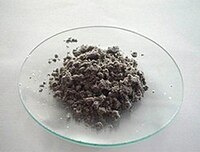
Photo from wikipedia
[Fe]-hydrogenase is a key enzyme involved in methanogenesis and facilitates reversible hydride transfer from H2 to N5,N10-methenyltetrahydromethanopterin (CH-H4MPT+). In this study, a reaction system was developed to model the enzymatic… Click to show full abstract
[Fe]-hydrogenase is a key enzyme involved in methanogenesis and facilitates reversible hydride transfer from H2 to N5,N10-methenyltetrahydromethanopterin (CH-H4MPT+). In this study, a reaction system was developed to model the enzymatic function of [Fe]-hydrogenase by using N,N'-diphenylimidazolinium cation (1+) as a structurally related alternative to CH-H4MPT+. In connection with the enzymatic mechanism via heterolytic cleavage of H2 at the single metal active site, several transition metal complex catalysts capable of such activation were utilized in the model system. Reduction of 1[BF4] to N,N'-diphenylimidazolidine (2) was achieved under 1 atm H2 at ambient temperature in the presence of an equimolar amount of NEt3 as a proton acceptor. The proposed catalytic pathways involved the generation of active hydride complexes and subsequent intermolecular hydride transfer to 1+. The reverse reaction was accomplished by treatment of 2 with HNMe2Ph+ as the proton source, where [(η5-C5Me5)Ir{(p-MeC6H4SO2)NCHPhCHPhNH}] was found to catalyze the formation of 1+ and H2 with high efficiency. These results are consistent with the fact that use of 2,6-lutidine in the forward reaction or 2,6-lutidinium in the reverse reaction resulted in incomplete conversion. By combining these reactions using the above Ir amido catalyst, the reversible hydride transfer interconverting 1+/H2 and 2/H+ was performed successfully. This system demonstrated the hydride-accepting and hydride-donating modes of biologically relevant N-heterocycles coupled with proton concentration. The influence of substituents on the forward and reverse reactivities was examined for the derivatives of 1+ and 2 bearing one para-substituted N-phenyl group.
Journal Title: Inorganic chemistry
Year Published: 2017
Link to full text (if available)
Share on Social Media: Sign Up to like & get
recommendations!